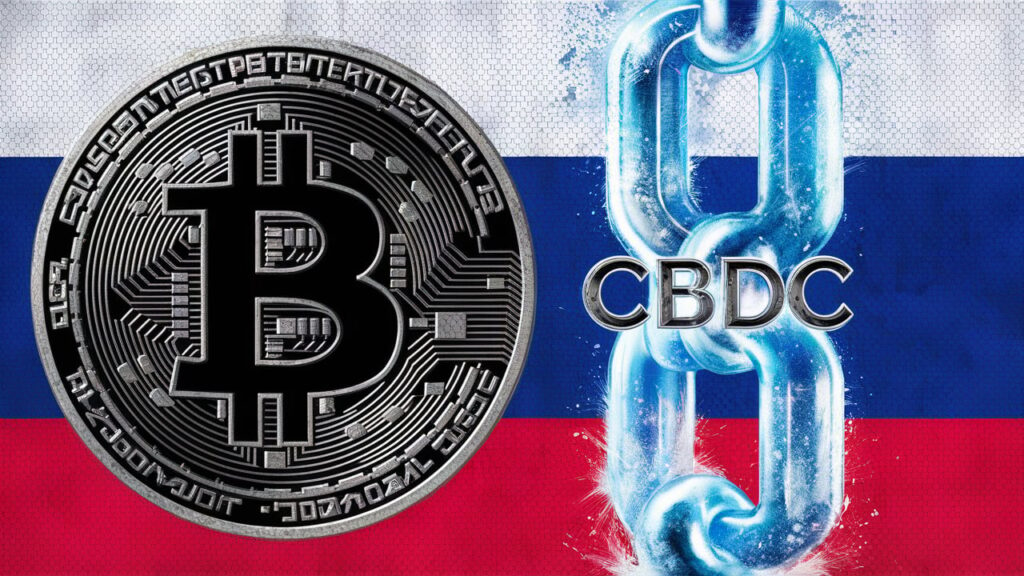9h10 ▪
6
min of reading ▪ by
CBDC or Bitcoin. Or both? One thing is certain, the Russian president is closely interested in all alternative payment systems.

Digital Ruble
The testing phase of the digital ruble is coming to an end. The Russian CBDC will soon become a full-fledged means of payment alongside cash and smart cards. This announcement was made on Wednesday by Vladimir Putin.
Speaking at a government meeting on economic issues, the Russian president expressed his satisfaction with the testing phase. The goal is now to implement it on a larger scale.
“The digital ruble pilot has shown that it is functional and efficient. We must now move to the next stage, which is a wider and larger-scale implementation of the digital ruble in the economy, in business activities, and in the financial field”, suggested the president.
The idea of introducing a national digital currency was unveiled by the Bank of Russia at the end of 2020. The testing phase began on August 1st of last year. Its purpose is to facilitate national, and especially, international payments. It aims to circumvent the SWIFT network from which Russia has been disconnected since the beginning of the war in Ukraine.
“This is essentially another form of our national currency. What is particular is that citizens and businesses can use the digital ruble regardless of the bank where they have an account”, emphasized Mr. Putin.
The test has so far involved only 600 individuals and 22 companies scattered across 11 Russian cities. It will be difficult to attract the masses. For two reasons. The first is that it will not be possible to borrow in digital ruble. Secondly, it will not be possible to earn interest on deposits.
A Ruble for International Use?
Given these limitations, there is a good chance that this CBDC will mainly serve for international payments. Tests have already been conducted with a number of foreign partners, said the vice-president of the Russian central bank, Olga Skorobogatova, to the TASS agency earlier this month.
The governor of the central bank, Elvira Nabiullina, suggested in April that full adoption of the digital ruble for mass use could take 5 to 7 years.
“It will be a natural process because the choice of citizens and businesses is fundamental: it must suit them”, she told the RIA Novosti news agency.
China seems to be about to finish five years of testing the eCNY. Indeed, the mention “pilot” (prototype) has just disappeared from the applications.
And while only 34,000 transfers and payments have been made in digital ruble, the eCNY facilitated 950 million transactions in 2023. However, this remains a drop in the ocean compared to the 542 billion transactions made via traditional payment systems (0.0017%).
It remains to be seen whether the conversion rates will be advantageous with these CBDCs. The fact that we have no information on this subject suggests that they are not. Only significant transaction volumes can remedy this.
All of this raises many questions:
- What technology is used? A blockchain without proof-of-work?
- What is the platform linking with other nations’ CBDCs? Mbridge?
Will the BRICS make an announcement at the Kazan summit in October?
And Bitcoin?
Vladimir Putin has drawn some ire from certain bitcoiners following his logical reprimands to bitcoin miners.
Vladimir Putin warned that cryptocurrency mining could lead to significant electricity shortages in some regions of the country:
“The uncontrolled consumption of electricity aimed at producing cryptocurrencies could lead to electricity shortages in some regions. We can already see this in the Irkutsk region, near Lake Baikal.”
Russia is indeed a heavyweight in the bitcoin industry. Analyst Jaran Mellerud estimates that 40% of the hashrate comes from the United States, 15% from China, and 12% from Russia.
The Russian president revealed that “nearly 1.5% of the total electricity consumption” is used by bitcoin miners. That is about 17.6 TWh. This gives us indeed 12% of the 146 TWh consumed by the bitcoin network if we are to believe the figures from the University of Cambridge.
A bill on the bitcoin industry will be considered on July 25th. Miners will likely have to report the extent of their installations and comply with limitations aimed at avoiding blackouts.
Another part of the law, however, is likely to be unpopular. Only international payments in bitcoin should be allowed. The law plans to ban payments on Russian territory.
Why so many fears? Bitcoin is not competitive against Mastercard, Mir, or Visa anyway. Conversion and transaction fees are too high. It can only be a relatively marginal means of payment.
Maximize your Cointribune experience with our ‘Read to Earn’ program! Earn points for each article you read and gain access to exclusive rewards. Sign up now and start accruing benefits.
Click here to join ‘Read to Earn’ and turn your passion for crypto into rewards!
Bitcoin, geopolitical, economic and energy journalist.
DISCLAIMER
The views, thoughts, and opinions expressed in this article belong solely to the author, and should not be taken as investment advice. Do your own research before taking any investment decisions.




